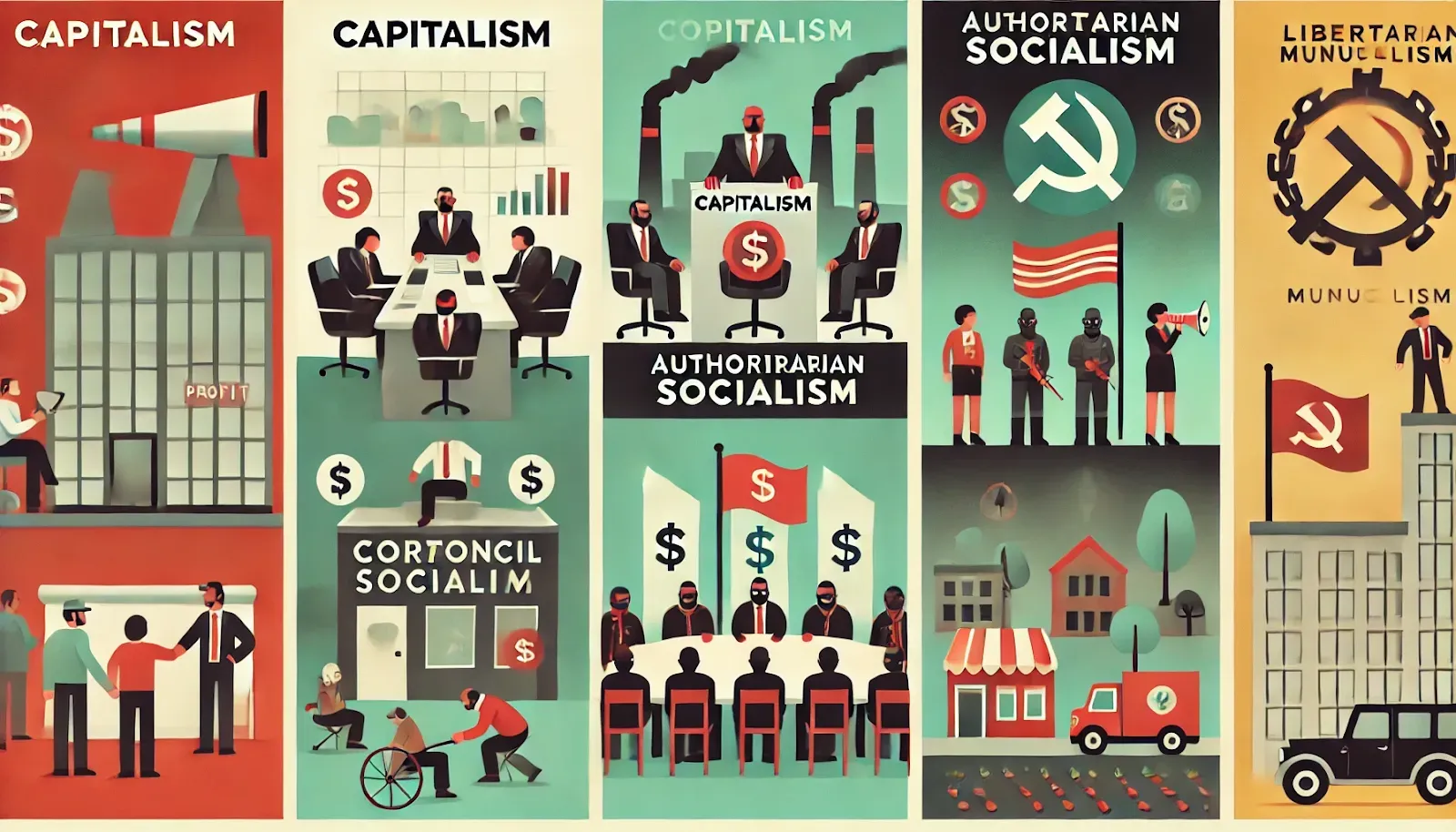Gothic Poems of Love & Liberty
A hauntingly beautiful collection of poetry that explores love, freedom, and the shadows of the soul.
A hauntingly beautiful collection of poetry that explores love, freedom, and the shadows of the soul.

The systems governing the ownership of resources and decision-making within societies shape the lives of billions. From Capitalism to Authoritarian Socialism and Libertarian Municipalism, these models represent contrasting ideologies and approaches to power, economics, and social organization. Each system impacts individuals, communities, and the environment in profoundly different ways, influencing access to resources, the balance of power, and the values that guide societal progress. This post critically examines these three models, presenting their defining characteristics, power structures, and societal impacts. It highlights how these systems address—or fail to address—key issues such as worker involvement, ecological preservation, and human welfare. By laying out these differences, the aim is to prompt reflection on the inherent inequalities and challenges each system poses. Whether it is the profit-driven motives of Capitalism, the centralized control of Authoritarian Socialism, or the decentralized, participatory approach of Libertarian Municipalism, this exploration seeks to provide a framework for understanding these ideologies. As you delve into this analysis, consider the profound implications of each system and the pressing need to question the status quo.

|
| @ Class with Mason: All Rights Reserved |
| Aspect | Capitalism | Authoritarian Socialism | Libertarian Municipalism |
|---|---|---|---|
| Ownership of Means of Production | Privatization of Means of Production | Nationalization of Means of Production | Municipalization of Means of Production |
| Workplace Power Structure | Dictatorship of Board of Directors or Bourgeoisie | Dictatorship of State-Sponsored Bureaucrats | Democracy of Workers and Municipal Council |
| Worker Involvement | Alienated from decision-making, credit, respect, and profits | Alienated from decision-making, credit, respect, and profits | Fully involved in decision-making; no alienation |
| Hierarchy | Top-to-bottom vertical hierarchical structure | Top-to-bottom vertical hierarchical structure | Horizontal power structures |
| Worker Relations | Relation of domination and dominated | Relation of domination and dominated | Relation of equality and consent |
| Protests and Violence | Workers can protest; capitalists manipulate politicians | Protesters are killed; regime enforces rule through red terror | No need for violence; rules are created and respected by the people |
| Impact on Ecology and Human Welfare | Profit over ecology and human welfare | Will of one party over ecology and human welfare | Ecology and human welfare are central to planning |
| Human Costs | Creates poverty and starvation, killing millions | Comes to power through bloodshed and mass killings. Keeps oppressing and killing | Nonviolent, pacifist approach using prefigurative politics |
| Governance and Ideology | Existing system, albeit slightly modified | Totalitarian regime; one-party dictatorship | Not anti-state; creates its own world through grassroots projects |
This analysis invites you to critically reflect on the complex realities of Capitalism, Authoritarian Socialism, and Libertarian Municipalism. While Capitalism might appear more humane compared to the oppressive regime of Authoritarian Socialism, it is not without its own evils. Capitalism, driven by profit, has fostered systemic inequalities, created poverty, and resulted in the deaths of millions through starvation and exploitation. Its longer reign has caused extensive damage to the earth and its ecosystems. However, given the chance, Authoritarian Socialism—with its absolutist, one-party rule—might have surpassed Capitalism's destructive legacy. Authoritarian socialism’s history of violence and suppression of dissent paints a grim picture of its potential to wreak even greater harm.
To explore the darker side of Marxism-Leninism and other authoritarian leftist ideologies, we recommend the comprehensive course The Limits of Marxism. Similarly, to delve deeper into the mechanisms and impacts of modern Capitalism, consider Capitalism in the Neoliberal Age.
In contrast, Libertarian Municipalism presents an alternative vision of society, focusing on ecological sustainability, human welfare, and decentralized ownership. Beyond municipalized resources, it incorporates additional innovative ownership models designed to prioritize community welfare and reduce material waste:
Libertarian Municipalism also explores other transformative practices, such as credit-hour banks, where labor hours are exchanged, and alternative currencies, which create economic systems independent of traditional markets. By fostering grassroots, prefigurative politics, Libertarian Municipalism demonstrates how societies can change from the ground up without violence or hierarchical domination.
Core Principle: Unlike capitalism and authoritarian socialism, libertarian municipalism operates without leaders, ranks, or top-to-bottom hierarchies, meaning there is no centralization of power. In this model, power is decentralized and distributed equally among the people, ensuring a system where decisions are made collectively and autonomously by the community, without the control of a single ruling authority.
For a deeper understanding of this empowering and nonviolent approach, consider joining our course Prefigurative Politics: How to Change Society from Below.